First Drive: Six-figure Ford Mustang GTD Boasts Peak Pony Muscle
If you think spending Lambo money on a Mustang is madness, Jim Farley would like to have a word with you. The Blue Oval CEO’s fondness for the O.G. pony car makes the 7-and-sometimes-8-figure-per-year exec seem more like Joe Six Pack than a captain of industry.
But his ‘Stang fanboying comes from the heart: he restored a 1964 ½ basket case at 15, acquired a ’65 Shelby GT350 years later, and has tracked all manner of Mustangs in between. Farley’s championing of the platform is well documented and was perhaps most clearly expressed when he shielded the Mustang from extinction during Ford’s 2018 shift to building only trucks, crossovers, and SUVs.
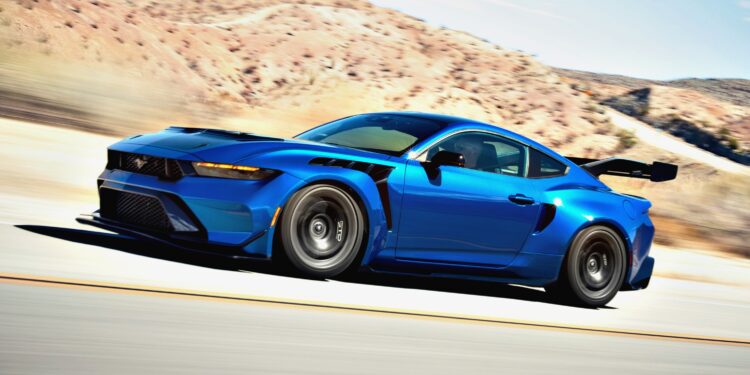
The big boss also embiggened the Mustang by throwing the model into a slew of race series, most critically GT3, where the humble American pony car competes against nameplates like Aston Martin, Ferrari, Lamborghini, and McLaren. When contextualized against those ultra-fancy competitors, a heavily spoilered, flared, vented, and $325,000 Mustang GTD starts to make a tiny bit more sense.
“Mustang is the flagship race car of the Ford Motor Company, and pretty much any given weekend we’re racing one somewhere,” GTD chief program engineer Greg Goodall told duPont Registry at the vehicle’s media launch in Thermal, CA. “We’re competing against the exotic European carmakers. Why wouldn’t we compete with them on the road?”
The first goal when building the baddest ass Mustang in all the land was establishing a killer Nürburgring time. “You can’t just tell people we’re like Porsche,” insists Goodall, “you have to measure it in some way.” Hence, the sub-7-minute time target.
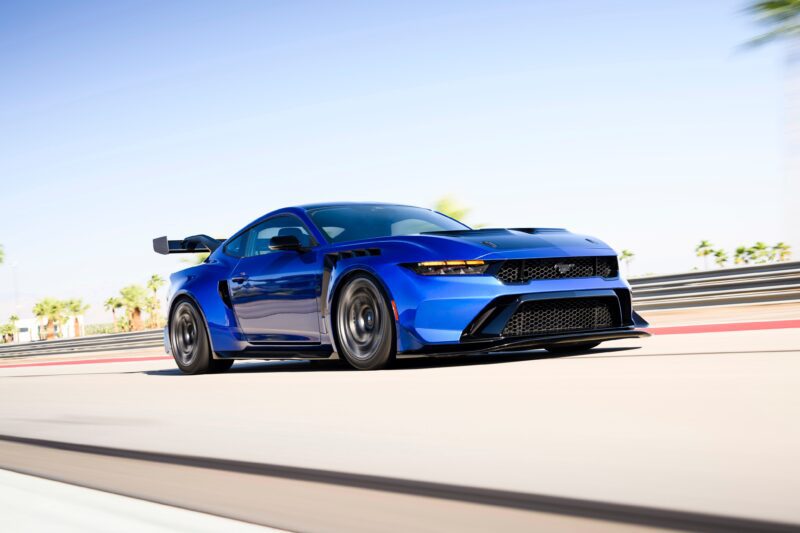
Things didn’t initially go as planned, as only three officially timed laps transpired in 2024 due to the weather at the 12.9-mile circuit. While an August run achieved 6:57.685, the team felt there was room for improvement, which inspired chassis, suspension, and aero tweaks, along with revisions to ABS and traction control tuning.
In May of 2025, Dirk Müller found 5.6 seconds, elevating the 815-horsepower muscle car’s 6:52.072 time just behind the Porsche 911 GT3 RS (6:49.328), Mercedes-AMG GT Black Series (6:48.047), and the Mercedes-AMG One (6:29:090). Even though GTDs are already in the hands of paying customers, Ford Performance says they’re still chasing a quicker lap time around the Eifel Mountain course.
Like that other performance-focused strain linked to international competition, the Ford GT, the GTD was executed through a deep collaboration with Multimatic. The transmogrification starts with a run-of-the-mill Mustang’s body-in-white that gets plucked from Ford’s Flat Rock, Michigan, plant to Multimatic HQs in Ontario.
The Mustang’s body-in-white is shipped without front fenders or a hood, which Multimatic replaces with a massively flared and vented pair of fenders and a carbon fiber hood with removable top grilles for track use. Deep surgery begins by plasma cutting and removing the second row, the rear floor, and the outer shell.
Much of that negative space gets filled with the Tremec 8-speed dual-clutch transaxle, which helps deliver near-perfect 50/50 weight distribution. Up front is an evolution of the Predator supercharged 5.2-liter V8 found in the GT500 and Raptor R, tuned to 815 horsepower and 664 lb-ft of torque. This application uses dry sump lubrication and drives power through a carbon fiber propshaft – all proper racecar stuff.

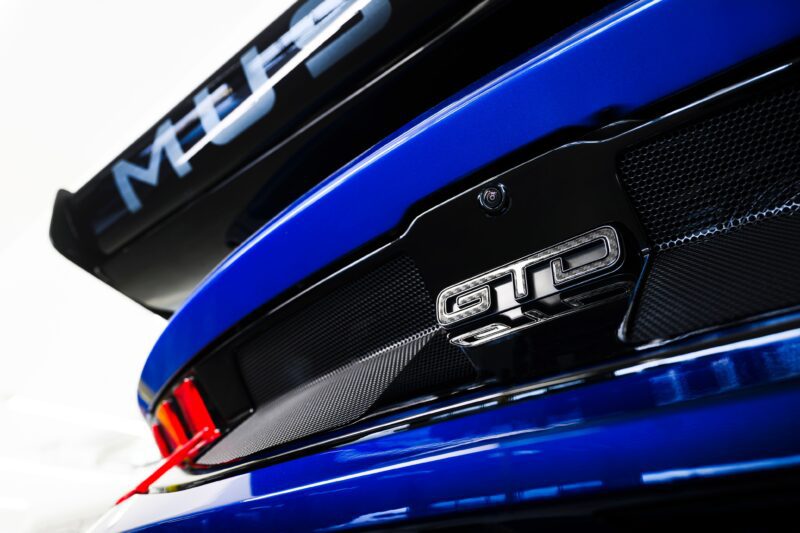
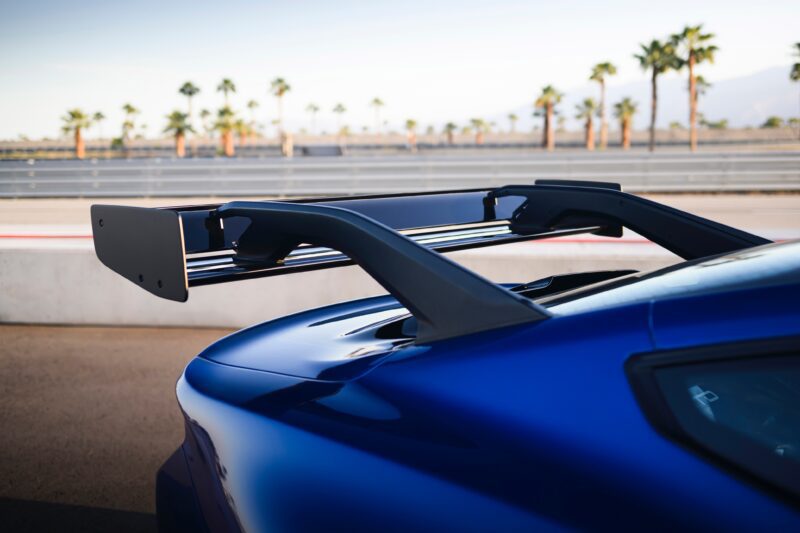
While the business may be in the front, the GTD’s party is definitely in the back. Due to the transaxle’s disruption of a space that was never intended to house it, Multimatic developed an inboard suspension system that leverages a similar setup to the late, great Ford GT’s. Using dual adaptive spool valve dampers, the suspension adjusts semi-actively within each drive mode. Also like the GT, a track mode (which requires the vehicle to be stopped and in Park to activate) drops the body dramatically in under 2.0 seconds, yielding a super low ride height and satisfyingly aggro wheel stance.
Incidentally, carbon fiber reinforcements mend the broken jigsaw puzzle of the GTD’s discombobulated rear end, lending it stiffer torsional rigidity than stock. They also crammed in heat exchangers to cool the transaxle, a massive active wing with DRS that mounts to the rear pillars, and the aforementioned pushrod suspension, which is visible inside the cabin through a Lexan window. Pro tip: Tilting the rearview mirror down while driving enables a clear view of the mesmerizing suspension kinematics. Don’t try this at home.

1 of 8

For all the visual theatre of the GTD’s flared, swollen, stanced, and steroidal body, the cabin is surprisingly – and disappointingly – normal. The usual Mustang bits abound, from the touchscreen display to the same HVAC implementation (which blows remarkably cold in 100+ degree weather, by the way) to the faux carbon fiber texture around part of the center console. Minor tweaks include the steering wheel’s adaptive cruise buttons, which have been repurposed to control the multi-stage traction control settings in Track mode.
Two days at the Thermal Club provide plenty of time to acclimate to the Alan Wilson-designed circuit in its maximum length, 5.1-mile IndyCar configuration, starting in Dark Horse Mustangs. Despite the annoyingly similar interiors, going from a $75,000, 500-horsepower Dark Horse to a $325,000, 815-horsepower GTD is like, well, going from a horse to a supercar.
The GTD’s supercharged V8 comes to life with a raw snarl, its titanium Akrapovič exhaust betraying its track-focused intentions. Surprisingly, though, it seems the supercharger whine has been quieted at speed. Despite this, there are a number of ways the GTD exceeds the GT3 race car. Though heavier, it also produces more power and boasts active aerodynamics and suspension. According to Goodall, the GT3 could outpace a GTD on smaller, more technical courses, though the GTD would likely get ahead on longer tracks.
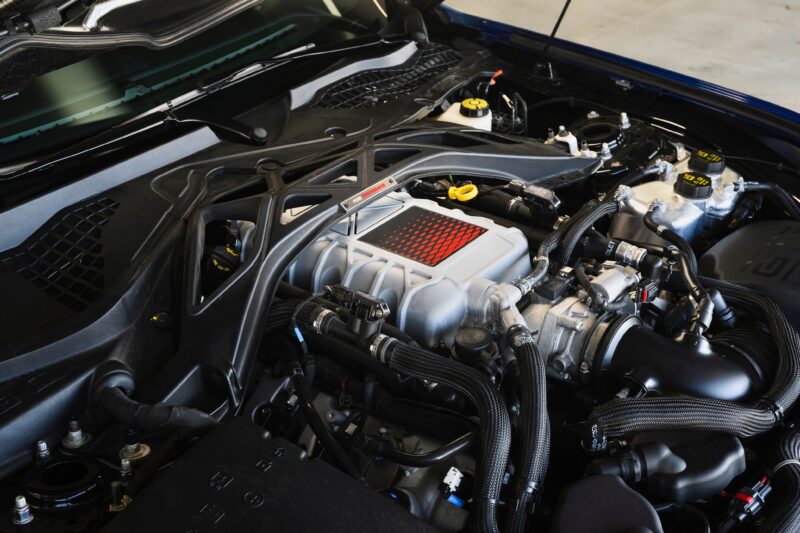
You’d never know the GTD weighs 4,386 lbs from the cradle of the specially developed Recaro driver’s seat; once accelerating, the V8’s tug is magnificent, the steering feel excellent, and the chassis and suspension remarkably agile. Overcook it into a corner, and a brake stab and steering adjustment tucks the ‘Stang back into form quickly.
This beast never feels like its mass is getting away from you, especially at higher speeds, since downforce escalates from 941 lbs at 125 mph all the way up to 1,951 lbs at 180 mph. Also commendable are the six-piston carbon ceramic Brembos, which produce powerful, easily modulated fade-free stops. Oh, and you can have any tire you want on the GTD… as long as it’s ultra-sticky Michelin Cup 2 Rs. As much as the GTD’s Hertz Rent-a-Car interior sends the wrong signals about its capabilities, its mercilessly aggressive bodywork and broad-shouldered stance sing to its true self.
And lest you suspect that well-heeled muscle car buyers will balk at the price, the order book is already full for the first two years of production. Fierce, controlled, and bombastic about performance, the GTD is the All-American M2 Browning .50 Cal to the GT3 RS’s Teutonic surgical scalpel. And if you’re wondering why Ford and Multimatic didn’t go even wilder with a full carbon fiber chassis, the answer is simple: it would no longer be a Mustang.
View All Ford Mustangs For Sale
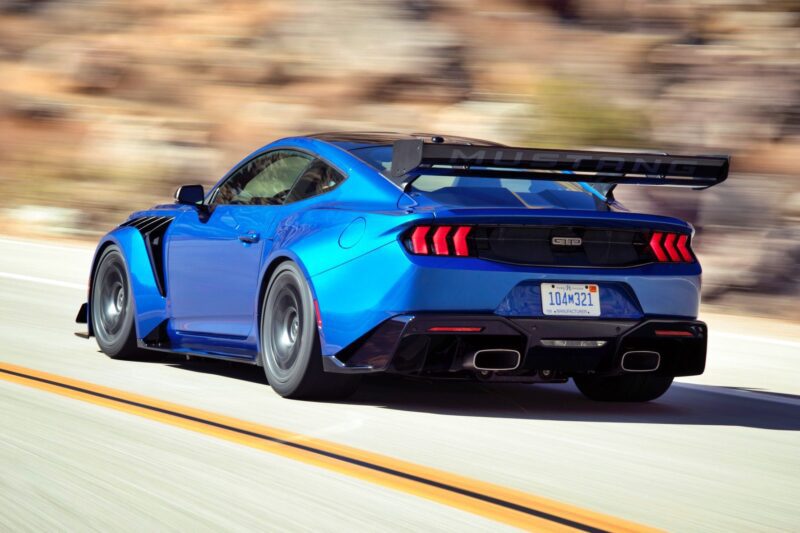
Images: Ford
Tags: Featured
More Power Than GTD: 2026 Mustang RTR Spec 5 Packs 870 HP
in Aftermarket, Ford News, Mustang

For well over a decade, RTR or Ready to Rock, founded by two-time drift champion Vaughn Gittin Jr., has built a reputation for turning Ford’s pony car into something sharper, more aggressive, and more track-capable. The current Ford Mustang doesn’t lack presence, but RTR’s latest package takes it into new territory, with a host of both visual and performance upgrades. Meet the 2026 Mustang RTR Spec 5 and priced at $159,999, only 50 units will be built per year, which means exclusivity is part of the pitch.
RTR starts out with a brand-new S650-generation Mustang GT (donor car included in the package), complete with the Performance Package and Recaro seats. From there, the changes are pretty extensive, as they include a Whipple 3.0-liter Stage 2 supercharger with an intercooler, which boosts the Coyote 5.0-liter V8’s output from 480 horsepower to a staggering 870 horsepower and 660 pound-feet of torque.


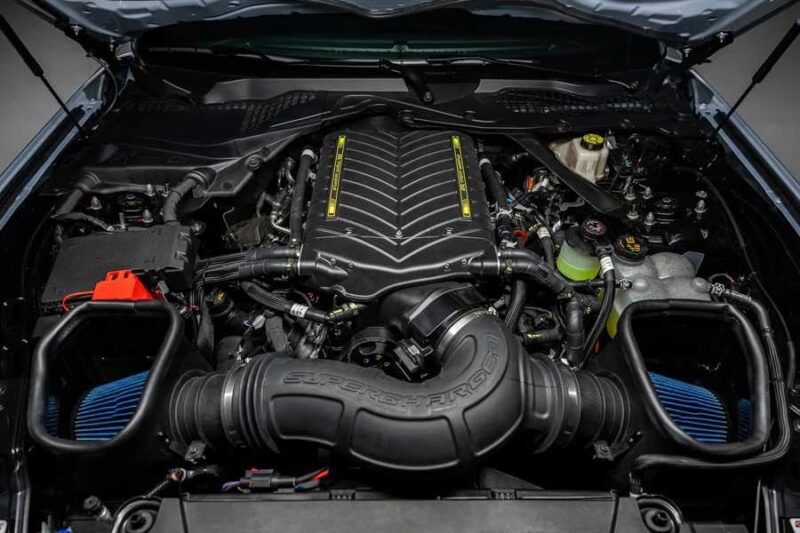
For some context, that’s more powerful than Ford’s own flagship record-setting 815-horsepower Mustang GTD. RTR insists this car “is built to OEM+ standards that meet or exceed Ford’s own benchmarks.” The exhaust deserves its own spotlight because RTR teamed with Borla to develop a cat-back system specifically tuned for the Spec 5.
Now, power is only half the equation, because RTR also equips the S650 with what it calls a “Tactical Performance Suspension System,” which includes 30-way adjustable coilovers, model-specific springs, and sway bars designed to balance track precision with street comfort. The setup was validated through CFD and track testing with drivers like Billy Johnson.
Throw in 20-inch forged RTR Aero 5 Evo wheels (available in Forged Charcoal, Podium Champagne, or Vapor Silver) wrapped in Michelin Pilot Sport 4S tires (305mm front, 315mm rear), and you’ve got a Mustang with far more grip than the base car. Even the underbody has been smoothed and reworked to create both suction and downforce. Brakes have also been upgraded with two-piece Brembo front rotors, which, considering the horsepower jump, should make a difference.
The styling is equally aggressive. A design effort led by Lindsay Ross, RTR, calls this its first full widebody system, which uses carbon fiber and composite panels. The distinctive front and rear fenders don’t just add visual punch and that wide body stance, but are also functional as they integrate cooling vents. Details like the pronounced carbon front splitter and ducktail spoiler are a direct nod to RTR’s Formula Drift lineage.

1 of 7

Paint choices range from nine standard and nine premium colors (+$7,500) to paint-to-sample options (+$15,000), and each car carries a graphics package inspired by drift racing. Inside, RTR touches include leather-trimmed Recaros in gray and black, a serialized plaque on the dash engraved with Gittin’s signature, and an RTR shift knob. You can also add a $1,199 racing harness if track days are part of your plan. The Mustang’s Drift Brake, co-developed with Vaughn and Ford, comes standard.
At $160,000, you’re nearly in Porsche 911 Targa territory but just over half as much as a $300,000 Mustang GTD. But you’re also getting one of the most powerful Mustangs ever made, not to mention one that still carries a warranty. If you’re someone who wants a Mustang that feels truly special, but also seeks a muscle car that bridges the gap between the Blue Oval’s factory specials and a full-blown drift car, then the RTR Spec 5 makes a strong case for itself.
View All Ford Mustangs For Sale
https://youtube.com/watch?v=bb38Fmr_h-c%3Ffeature%3Doembed%26enablejsapi%3D1%26origin%3Dhttps%253A%252F%252Fnews.dupontregistry.com
Images: RTR Vehicles
Related Articles
Limited to 60: Inside the 1,000-HP YENKO C8 Corvette With COPO Roots
in Aftermarket, Chevrolet, Corvette, For Sale

Image Source: Specialty Vehicle Engineering
Regardless of whether you’re a GM fan or not, Yenko is a name you’ve most likely heard of if you’re even remotely into American muscle cars. For decades, it’s been tied to outrageous Camaros and big-block Chevys, with its roots running straight through to Don Yenko and the Central Office Production Order (COPO) system that gave us legends like the original ZL-1 back in the late 1960s.
While we’ve seen the Yenko-name appear on modern Camaros, that same factory-backed dealer-driven performance didn’t appear on GM’s radically different C8 Corvette, until it was now. First announced in 2024, this is the 1,000-horsepower Stage I twin-turbo Yenko C8 Corvette, a limited-run mid-engined exotic being built by Specialty Vehicle Engineering (SVE), a second-stage manufacturer and Tier One supplier to both GM and dealers, who have delivered over 65,000 vehicles.
That headline horsepower figure puts it right in line with the upcoming ZR1X, which Chevrolet itself is positioning as a hypercar, because it produces 1,250 horsepower from its hybrid-assisted twin-turbo setup. The Yenko C8, however, doesn’t rely on electrification. Instead, it extracts four-figure power from its custom-built LT2’s 6.2-liter V8, which employs a pair of Garrett 58 mm ceramic ball-bearing turbos, forged internals, CNC-ported heads, and a proprietary camshaft. The headline 1,000 horsepower is on pump gas. With a stage II tune and flex fuel, you’re looking at 1,200 horsepower. Compared to the stock Stingray’s 495 horsepower, the potent Z06’s 670, or the 1,064 horsepower ZR1, the Yenko pushes the Corvette into territory you usually only see with top-tier hybrid supercars these days.

1 of 7

A forged steel crankshaft, H-beam rods, and 2618 aluminum pistons anchor the bottom end, while ARP studs keep it all together. Upgraded high- and low-pressure fuel systems ensure those turbos never starve. Even the valve covers have been reengineered to integrate oil separators, and the 8-speed dual-clutch automatic transmission has also been beefed up to handle the additional load, with power going exclusively to the rear wheels.
Inside, every car will feature Yenko sYc embroidery on the headrests, unique floormats, and bespoke badging. While the car seen here is a vibrant blue with custom white stripes and wheels, you can also choose from 14 factory paint colors, nine graphic packages, optional carbon fiber elements, and even calipers painted to match the stripes. All graphics feature OE-quality UV-resistant vinyl to ensure they hold up over time.
So, does a 1,000-horsepower Corvette make sense in practice? The Stingray is already sub-three seconds to 60 mph, and the Z06 delivers track-ready performance without turbos. However, when you factor in the rarity, just 60 will be built (50 coupes and 10 convertibles), the COPO connection, and the Yenko name backed by GM dealer support/warranty, this limited-run special makes a compelling case as a future collectible.
Images: Specialty Vehicle Engineering
Related Articles

Own An Exquisite Luxury Tourer: Bentley Continental GT/GTC
Luxury grand touring doesn’t get much better than this. When…

Five Reasons Why To Buy The Electrified McLaren Artura
With the electrified Artura, McLaren started with a clean sheet…

Go Beyond Red: Ferrari’s Craziest Colors For Sale
Red isn’t the only color that looks great on a…

Discover The Most Iconic And Exclusive Lamborghinis For Sale at Lamborghini Montreal
From multiple Murcielagos to the new Countach LPI 800-4, Lamborghini…



